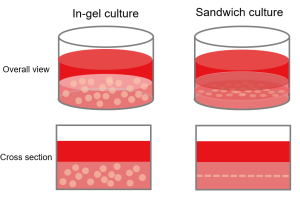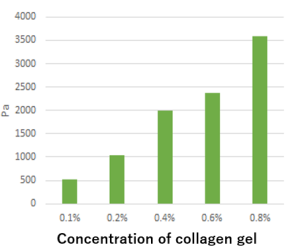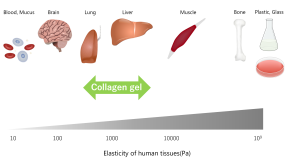Show Q&A menu
- 3D Ready Atelocollagen
- Collagen Acidic Solutions/Neutral Solutions
- 3D Honeycomb Boosted
- Atelocollagen, Honeycomb Sponge
- Atelocollagen Sponge, MIGHTY
- Atelocollagen Coated β-TCP Scaffold
- Atelocollagen Microspheres
- Collagen Sponge for 35 mm Culture Dish
- FibColl® Atelocollagen Inserts 24
- Atelocollagen, Permeable Membrane
- Type II Collagen
- Atelocollagen Powder, Membrane, Sponge
- Others
3D Ready Atelocollagen
What is atelocollagen?
Telopeptide is a non-helical structure at both ends of the collagen molecule and is thought to be involved in intermolecular bonding and allergenic reaction due to antigenicity. Removing the telopeptides from collagen by protease treatment produces atelocollagen whose characteristics are superior purity and stability. We have produced atelocollagen-based medical devices for more than 30 years.
What is the size of the collagen molecule?
The size is approximately 300 nm in length and 1.5 nm in width, and the molecular weight is approximately 300,000.
Collagen is composed of three molecular chains that form a triple helical structure.
The molecular chain is a polypeptide consisting of approximately 1000 amino acids bound together in a unique amino acid sequence of collagen repeating [Gly-X-Y].
Phenylalanine, histidine, proline, glutamic acid, and leucine are primarily in the X position, whereas hydroxyproline and hydroxylysine are typically found in the Y position.

What types of collagen are contained in 3D Ready Atelocollagen?
The source of collagen is bovine dermis and therefore both products contain approximately 95% type I collagen and roughly 5% type III and type V collagen.
What is the glucose concentration of 3D Ready Atelocollagen?
3D Ready Atelocollagen DMEM-LG (Low Glucose) contains 1,000 mg/ml of glucose, and 3D Ready Atelocollagen DMEM-HG (High Glucose) contains 4,500 mg/ml of glucose.
How do I store 3D Ready Atelocollagen?
After the initial thaw, the product can be kept refrigerated for one month. For long-term storage, dispense a small amount at the time of initial thaw and store frozen. Freeze-thawing should be avoided because it affects the gel-forming capacity.
Can 3D Ready Atelocollagen be diluted?
It can be diluted by adding serum-free medium (e.g. DMEM) under ice-cold conditions and then mixing slowly* without whisking.
Note, however, more dilute the product is, the less viscous it becomes and the longer it takes to form a gel, while cells are more likely to accumulate.
*Swirling agitator (rotator) at 4 rpm for 20 min, etc.
How can I prepare collagen coatings/collagen gels?
Please visit our distributors’ page to download an instruction manual.
Has atelocollagen been used for organoid culture?
Atelocollagen has been used to culture primary mouse small intestinal organoids, primary mouse mammary organoids, and organoids from human brain tumor stem cell lines.
Can cells cultured on a gel with atelocollagen be observed?
Because each cell is at a different height in the gel, the microscope cannot focus on every cell; however, the morphology of individual cells can be observed.
If you want to culture cells at a certain height, consider sandwich culture in which a collagen gel without cells is formed first, cells are seeded on top of the collagen gel, and then another layer of collagen gel is added.

How strong is the atelocollagen gel?
The graph below shows a representative measurement of compressive strength.
Plastic petri dishes and plates for culture are much stronger compared to tissues.
On the other hand, the strength of the atelocollagen gel is closer to that of native tissue and decreases at lower collagen concentrations.
If you are interested, please also see the video about the collagen gels.


Source of illustration: ©2016 DBCLS TogoTV / CC-BY-4.0
Is it possible to prepare sections from collagen gel?
Similar to tissue samples, collagen gel can be fixed and/or embedded in paraffin/OCT compound. Please visit our distributors’ page to download an instruction manual.
How can I analyze protein expression in cells cultured on collagen gel using western blotting?
The extract obtained by lysing the cells together with the gel using lysis buffer can be analyzed by western blotting as is. If the protein of interest cannot be detected, the collagen gel should be lysed in advance using collagenase*.
*Commercially available collagenase for cell dispersion contains a wide variety of proteases; therefore, ensure that the collagenase you use does not contain an enzyme that degrades the target protein.
Is there a high concentration collagen solution that is ideal for cell transplantation?
We can provide a collagen solution equivalent to that used in manufacturing our atelocollagen-based medical devices as a made-to-order research product. Alternatively, a high concentration collagen solution can be prepared from Atelocollagen powder (Cat No. CLP-01).
What are the differences between soluble basement membrane extracts and collagen solution?
Our collagen solution does not contain cell-derived physiologically active compounds, nucleic acids, matrix metalloproteinase (MMP), etc., which could affect the results of your experiment. Unlike soluble basement membrane extracts, we confirm the lot-to-lot consistency of our collagen products.
Information on this page is based on published articles and in-house data.